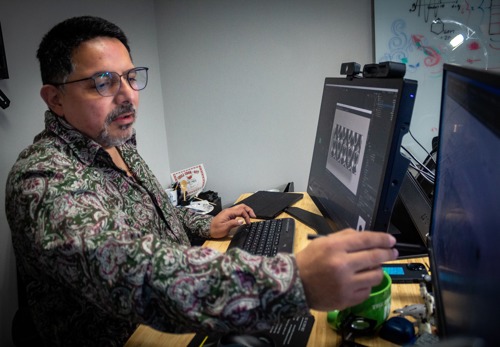Not many 3D designers in the world have had the opportunity to change an entire industry. Using their skillset to innovate security design technology – helping all of us to quickly identify if a banknote or product is genuine or not. Washington Egas is one of the few who has seen the evolution from the inside. His career in designing holograms came to a quick halt when he saw micro-optics, a new security feature that just blew his mind. Today, Washington is one of Crane’s top micro-optic designers in Alpharetta, Georgia.
“I still remember the feeling when asked to create a potential new security feature for the 100-dollar bill when working at American Banknote Holographics. The reference was this new 3D technology on my desk that was sharp and had an incredible depth to it. I tried to simulate it with holograms, but the result was just blurry,” says Washington Egas.
The $100 banknote became iconic worldwide with its blue 3D Security Ribbon and its Liberty Bells quickly changing back and forth to the numeral “100”. That was one of the first new generation of micro-optic security threads from Crane Currency and many more have followed with new effects, colors and public engagement features.
Banknote Security and Product Authentication
Today, variants of this technology are not only used as the primary security feature on countless banknotes on five continents, but also on product labels. Independent scientific studies have proved that the strong visual effects enabled by micro-optics are more intuitive and easier to verify than the complex details and light-dependent appearance of holograms, e.g. the public perception study presented at Crane’s Public First event by Professor Jane Raymond, CEO of Secure Perception Research. That is crucial for the fast assurance needed for building and maintain the trust of users.
The teams involved in making micro-optic security possible span across all of Crane’s locations. The heart of the technology is found in Alpharetta, a small city north of Atlanta, Georgia. This is the homebase for Washington Egas and Crane's growing number of micro-optic designers and animators.
“The team here is just incredible and very dedicated. Once you have ultra-microprinting and multicolor 3D animations in your blood, you can’t get it out of you. Working with micro-optics is a fine balance between art and engineering,” he says.
Washington started as a micro-optic security designer at Crane Currency in 2015. He is originally from Ecuador and came to the US when he was 16 and began as a graphic and 3D animation designer in 1995. For more than 20 years, Washington has worked with conceptual design and high security solutions used by governments, financial institutions and corporations.

Early Years with Holograms
Thirty years ago, holograms were a relatively new technology in the security space. At the time, Washington worked on holograms used on credit cards like Mastercard, Visa, American Express and Diners Club. He did laminates for identification documents such as the National ID for both Colombia and Pakistan.
During his years in New Jersey working for Viavi Solutions (JDSU) and later OpSec Security, the holographic technology had improved. But the results were still blurry and shallow when Washington tried to create the perception of depth.
“That is the nature of holograms. With micro-optic technology, the image can be as sharp as we want independent of the feature's thickness,” says Washington. Complicating things still more was the steadily increasing availability of commercial materials, including decorative foils and films which were especially useful for simulating holograms. These have since flooded the market and it’s no secret that almost anyone can make hologram simulations using a low-cost foiling machine, a laser printer and some ingenuity.
Metallic Appearance and Microscopic Details
Simply described, holograms have a micro-structure layer that consists of metallized material. A polymer liquid is added, pressure applied and then exposed to ultra-violet light. The final hologram’s appearance then still depends on the lighting condition and viewing angle.
The pursuit of obvious movement effects is frustrated by the technology’s limits – try to design in too much movement and the image becomes blurry. Combined with a lack of depth, the result can take on a grey, metallic look.
“I learned from my hologram years that you often include too many details. It then becomes blurred and shiny – and people tend to look away. A hologram also needs bright light to get our attention,” Washington explains.
With micro-optics on the other hand, you see movement right away. It looks alive in any lighting condition, and you can use the full breadth of Pantone colors and avoid being restricted to a narrow set of RGB colors.
He remembers the first micro-optic security feature he worked with at Crane, a RAPID® thread for the Central Bank of Bolivia and then later micro-optic security threads for Argentina. It used simple icons with pulsating symbols and movement.
“I had used a similar approach when working with holograms. The result then was rather flat, but with the micro-optics, I could see the depth when moving the note. The symbol was almost floating in space and the texture was moving behind it,” Washington recalls with ill-concealed enthusiasm.

A High Security System Combining Icons, Micro-Lenses and Ink
Micro-optics should not be seen as a simple security feature, but multilayered optical devices built with proprietary materials and formed by a complete security system. Micro-optics combine icon layers, lenses smaller than the width of a human hair, specialty inks printed at the micron level and precise alignment between all elements in all directions.
“From a designer’s perspective, I still amaze people when showing them how we use microscopic ink particles to create these 3D animations on a 2D print surface. Everything has to work together and involves teams working with design, software development and the physical production of micro-optic stripes and labels,” says Washington.
One micro-optic design challenge for banknotes is the very small canvas provided by the feature’s form, i.e., of 3 to 12 mm in width. The goal is to keep designs simple and at the same time, make it secure and impossible to copy and simulate effectively.
Multi-layered Security for Brand Owners
Simplicity is a guiding star for Authentic by Design™, Crane Authentication’s approach to product authentication. The core labeling and packaging solution is PROFOUND™ Micro-Optics, offering multi-layered security to brand owners. Crane integrates several levels of security technology depending on a customer’s strategy and activities, e.g. QR codes, serialization, tamper evidence, etc.
“These micro-optic labels are virtually impossible to counterfeit. Our design team is also working closely with brand owners to include effects that encourage their consumers to interact with the product intuitively – and raise the bar for criminals even further,” Washington explains.
With Crane’s software capabilities, ongoing R&D programs and vast design expertise, we should not expect anything less than a continues flow of new micro-optic movement and cool 3D effects.
For the packaging industry, Crane is working with labeling and software partners to protect the identity and reputation of well-known brands across major industries. Crane is also exploring the possibilities with QR codes and finding the right micro-optic design balance on each customized label.
When talking about future products, Washington Egas gets excited but at the same time retains a bit of caution.
“We have just gotten started with micro-optics and I wish I could talk more about the designs we are working with right now. We are doing really sophisticated things and creating almost living 3D images on printed surfaces. It will blow people away and make them ask ‘How is that even possible?’ says Washington Egas with a smile.

